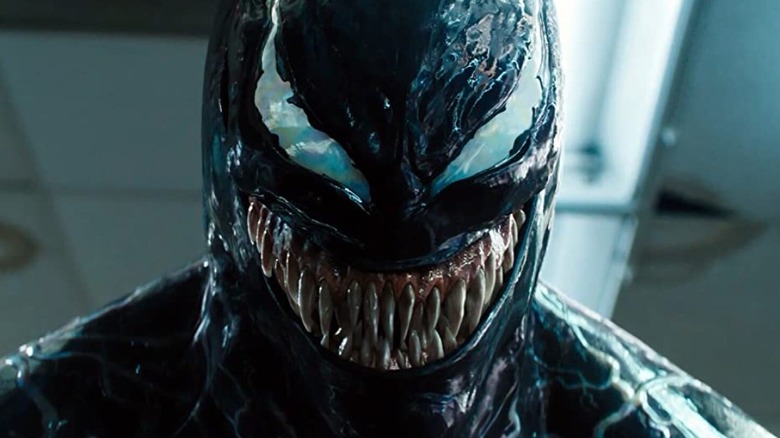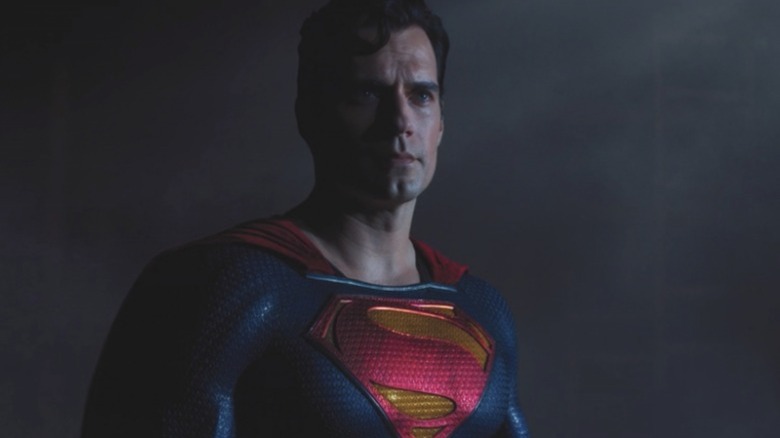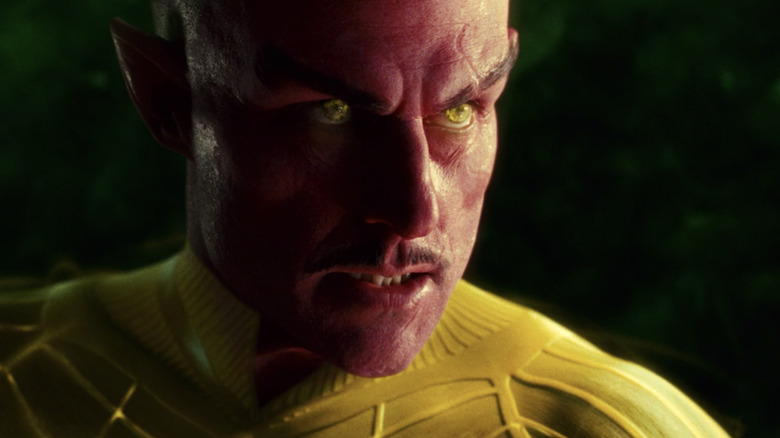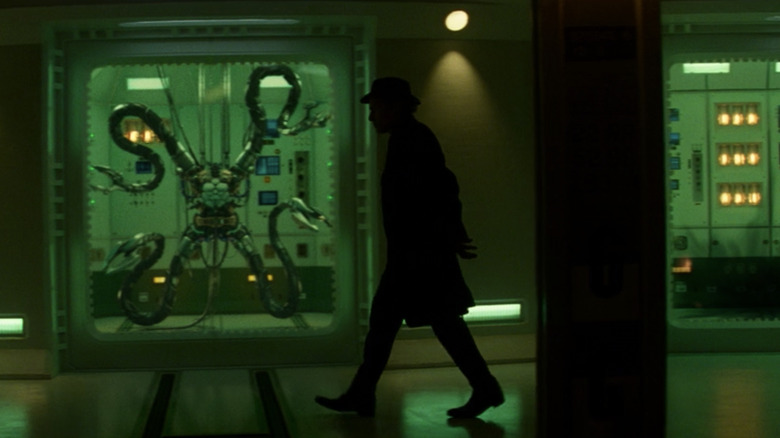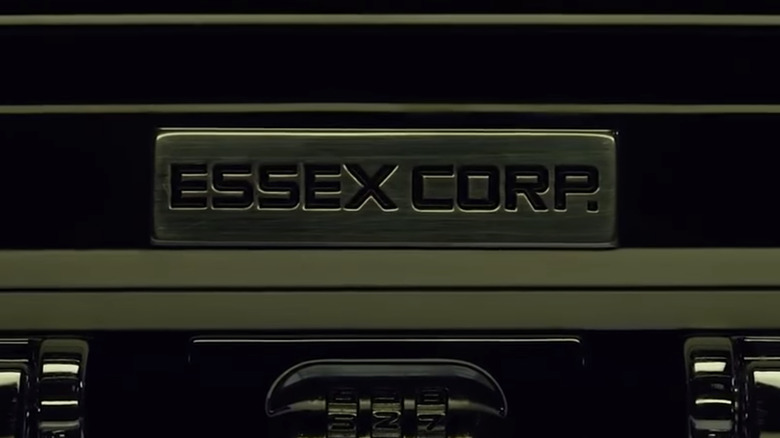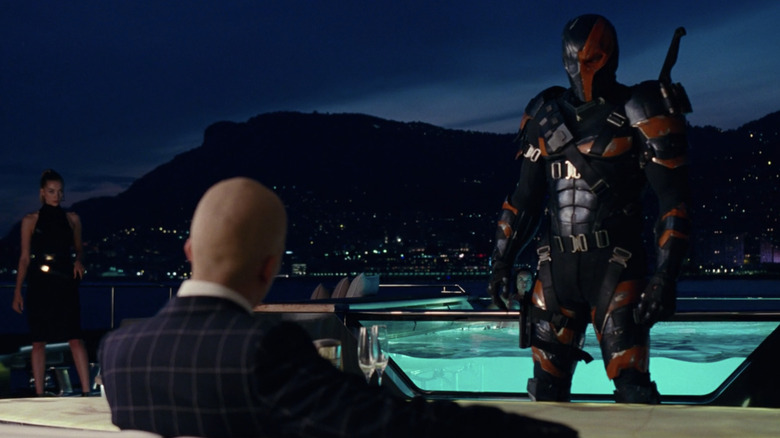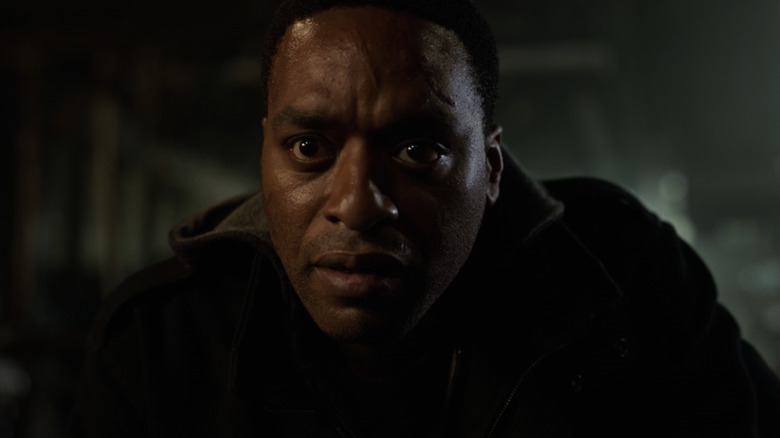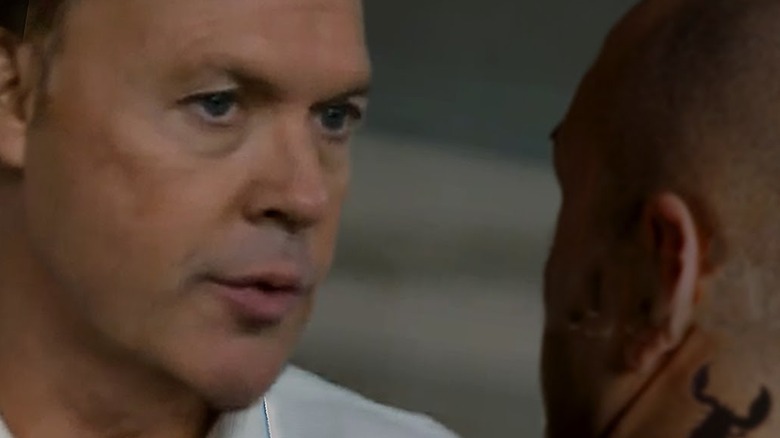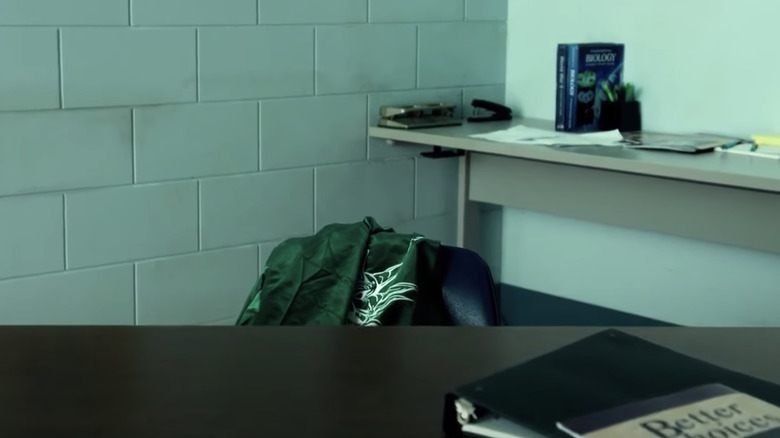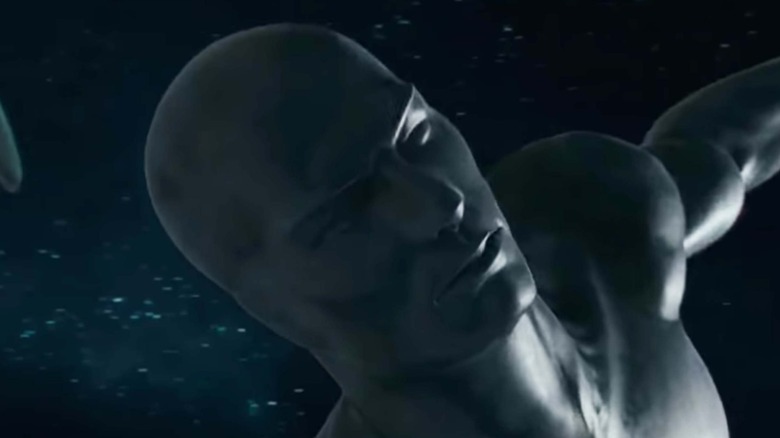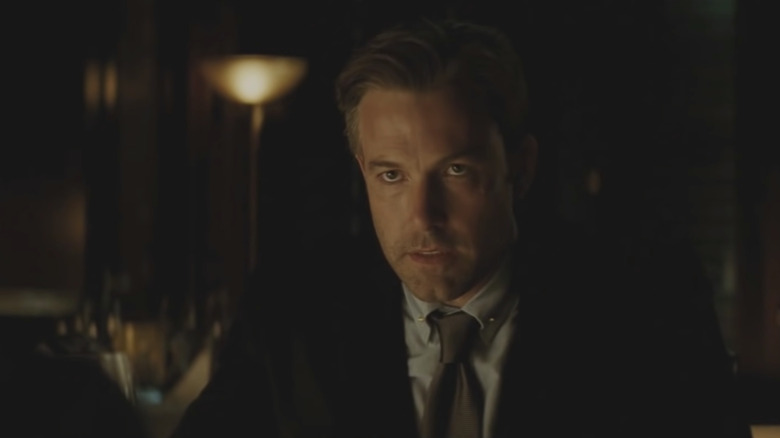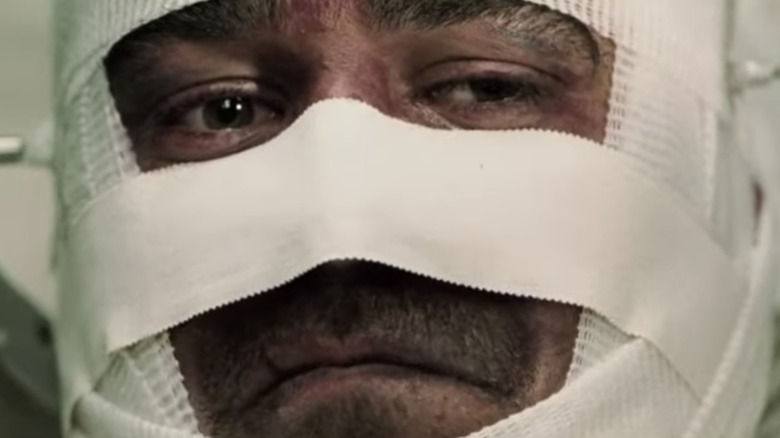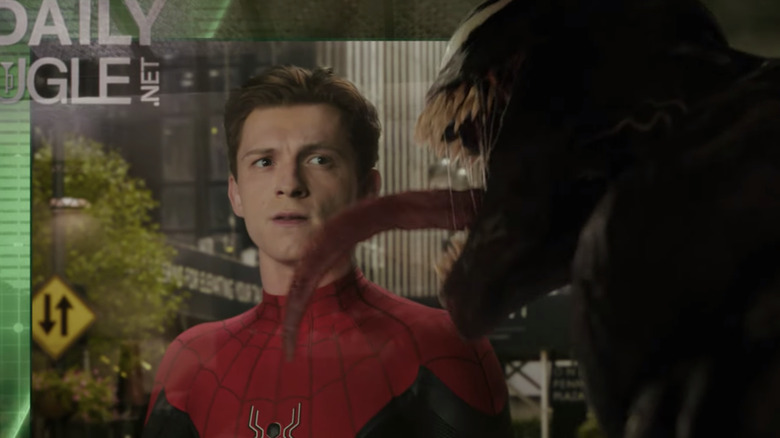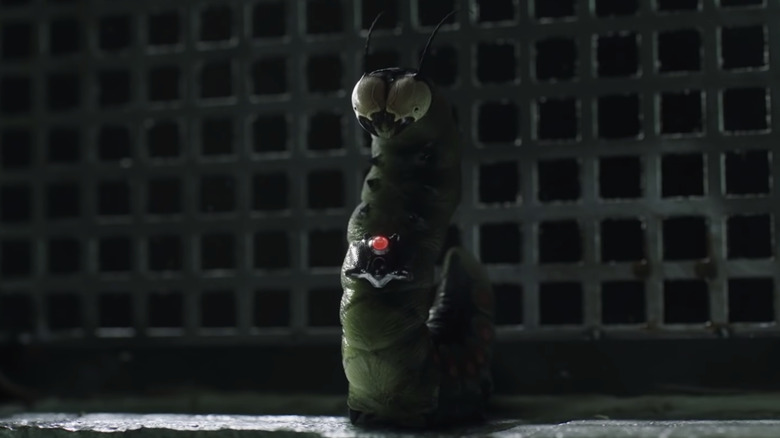Superhero Movie Post-Credits Scenes That Were Never Paid Off
Since the dawn of the modern-day superhero movie with the likes of Sam Raimi's "Spider-Man" and Brian Singer's "X-Men," seeing comic book heroes come to life on screen has become more than just common, but expected. When Marvel Studios birthed their famed cinematic universe with 2008's "Iron Man" and Christopher Nolan worked to re-establish Batman as a respectable icon through "The Dark Knight" trilogy, everyone attempted to follow suit. While there are countless tropes and cliches that superhero movies now tend to follow, one of the biggest is a post-credits scene that teases even more to come.
While superhero films didn't invent the post-credits scene, they've certainly co-opted them as part of the genre — so much so that it's infinitely more shocking if a superhero movie doesn't have one. Whether it's a tease regarding the future of the universe or a simple 20-second joke you waited seemingly forever to hear, the post-credits scene — which also includes the infinitely better mid-credits scene — is just one of those tropes that doesn't want to die.
Unfortunately, not every post-credit scene pays off. We live in a world where DC Studios is completely restructuring and Marvel Studios makes you watch every single piece of film and TV they put out just to understand the overarching story. That sometimes makes post-credits teases a bit more complicated — and oftentimes completely unnecessary. But, of all the post-credits teases out there that never paid off, these are by far the worst offenders.
Superman's return in Black Adam
When "Black Adam" first arrived in theaters, fans were ecstatic about the return of Henry Cavill as Superman. Having first appeared as the character in "Man of Steel" nearly a decade prior, Cavill hadn't played Superman since 2017's "Justice League" and the "Snyder Cut" version released in 2021. At the end of "Black Adam," Superman confronts the titular antihero, acknowledging his power and claiming that the two of them need to talk, getting fans excited for a Superman/Black Adam showdown. Soon after, Cavill announced his return as the character for good, hoping to move forward with a "Man of Steel" sequel.
Unfortunately, Cavill's announcement was annulled two months later, with his tenure as Superman ending faster than a speeding bullet. Evidently, new DC Studios co-CEOs James Gunn and Peter Safran decided to go in a different direction with the character, with Gunn himself writing a new Superman film without Cavill's involvement. Though we got Cavill's Superman back for a moment in "Black Adam," it seems that it was all for nothing.
Naturally, Superman fans everywhere were unhappy with this news, and although "Man of Steel" isn't the most beloved Superman film, just about everyone agreed that Cavill himself was never the problem as he embodied both the character and the role perfectly. While many are still holding out hope that Gunn and company will change their minds, the truth is that this epic "Black Adam" moment will probably never be followed up on screen.
Sinestro's turn to villainy at the end of Green Lantern
When Phase One of the Marvel Cinematic Universe began to really kick off, DC and Warner Brothers wanted to do something similar. They figured it was time to thrust a lesser-known hero into the spotlight. Enter "Green Lantern," a superhero movie that fell flat by most accounts and is infamous for attempting to launch a franchise that went nowhere. While "Green Lantern" isn't unique in that regard — we're looking at you, "Dark Universe" — it's also not all bad.
Besides some sweet moments between Hal Jordan and Carol Ferris — played by real-life couple Ryan Reynolds and Blake Lively — Mark Strong's Sinestro was a highlight among fans. After the Green Lantern Corps defeats the sentient space-cloud Parallax, the Earth is saved and Hal Jordan praised as a hero. But, little does Hal know, Sinestro hopes to harness Parallax's power for himself into a yellow power ring fueled by fear — just like his comic book counterpart.
Since Sinestro was hands-down the best part of "Green Lantern," it's disappointing that a post-credits scene teasing his turn to the dark side won't be followed up. As one of DC Comics' greatest villains and most complex characters, Sinestro deserves a proper fall from grace, and while "Green Lantern" began his descent, the lack of a proper sequel keeps his story from its completion. It's a shame: a Hal Jordan/Sinestro battle of the wills would have been explosive on screen.
The rise of the Sinister Six in The Amazing Spider-Man 2
Okay, so this isn't technically a post-credits scene, but we're gonna let this one slide because it's actually a continuation from the mid-credits scene we see at the end of the first "Amazing Spider-Man." Minutes before the credits roll on "The Amazing Spider-Man 2," the film teases the creation of the Sinister Six in order to fight and destroy the titular wall-crawler. Of course, the Marc Webb-helmed "Amazing Spider-Man" series ended with this picture, meaning that the plotline introduced in this would-be post-credits tease was completely scrapped.
Before the cancellation of the unproduced third and fourth "Amazing Spider-Man" films, there was even a "Sinister Six" feature in development that would set Spidey against his most famous rogues. But following the Tom Holland/Marvel Studios reboot that began with "Captain America: Civil War" and "Spider-Man: Homecoming," that was quickly pushed to the backburner also. Andrew Garfield's Spider-Man couldn't catch a break on screen, and it seems like his planned franchise couldn't either.
With Sony's Spider-Man Universe now revolving around the likes of "Venom" and "Morbius," it seems like plans for a new Sinister Six are well underway, even if Andrew Garfield's Spider-Man won't be the one to face them in combat. But hey, at least his triumphant return in "Spider-Man: No Way Home" was well-received. Here's hoping we can see his story continue beyond his time in the MCU with the other Peter Parkers.
Mr. Sinister tease at the end of X-Men: Apocalypse
With inconsistent timelines, rapid continuity errors, and plenty of misrepresented characters and comic book storylines, the "X-Men" movies are a bit of a mess. But that doesn't mean we don't still love the ride. After a few misfires, Fox performed a soft reboot by making the prequel film "X-Men: First Class," which brought some much-needed fresh air into the franchise. After rebooting even further with time travel shenanigans in "X-Men: Days of Future Past," the franchise was primed to be remodeled into something great. Then came "X-Men: Apocalypse."
"Apocalypse" is nowhere near the worst "X-Men" film, but for many it was a bit underwhelming. Nevertheless, the film's post-credits scene teased an exciting new direction for the "X-Men" films to take. Having adapted Apocalypse, one of the X-Men's greatest foes, to the big screen, this teaser saw men from the Essex Corporation taking the blood of Hugh Jackman's Wolverine for their master, Nathaniel Essex, aka Mr. Sinister.
Known best for his work in genetic manipulation and cloning, the promise of Mr. Sinister was exciting for longtime X-fans, and with the world of "X-Men" rebooted, the possibilities were endless. Sadly, Mr. Sinister never appeared in any live-action "X-Men" project and the next film was another poor adaptation of the beloved "Dark Phoenix Saga" that was somehow worse than the first attempt in "X-Men: The Last Stand." But Wolverine's blood went toward the creation of Laura in "Logan," so at least there's that.
Deathstroke and the Legion of Doom in Justice League
There isn't a superhero movie in recent years more controversial than "Justice League." No doubt, the 2017 theatrical version of the film — directed largely by Joss Whedon — leaves a lot to be desired, and has become one of the most hated superhero flicks out there. By contrast, "Zack Snyder's Justice League" is notably better and considered by some to be the genre at its best. But no matter which version you prefer, both share a similar scene that teases the expansion of the DC Universe.
After the Justice League defeats Steppenwolf, a post-credits scene sees Lex Luthor summon Slade Wilson, aka Deathstroke, to aid him in establishing a "league of [their] own." While Lex seems interested in creating their own Injustice League or Legion of Doom, it seems that Warner Brothers is not at all interested, as no sequel to either version of "Justice League" will probably be greenlit in the near future.
Mordo's quest to kill all sorcerers in Doctor Strange
The first "Doctor Strange" saw the titular hero become the Sorcerer Supreme after years of training in the magic arts. Under the direction of the Ancient One (Tilda Swinton), Stephen Strange (Benedict Cumberbatch) became the most powerful sorcerer, but not the only one. Another mentor, a sorcerer named Karl Mordo — based on the Marvel Comics character Baron Mordo — helped Strange fulfill his destiny only to leave the magical order after countless rules were broken by both Strange and the Ancient One.
In the film's post-credits scene, Mordo (Chiwetel Ejiofor) begins killing other users of the mystic arts and stealing their power after deciding that what's wrong with the world is that there are "too many sorcerers." Something of a fundamentalist, Mordo is teased as the next big villain for the "Doctor Strange" saga, hoping to eventually challenge Strange himself. While he doesn't appear in "Avengers: Infinity War," Baron Mordo shows up again in "Doctor Strange in the Multiverse of Madness." Well, sort of.
Rather than continue the plot thread established in the first "Doctor Strange," the sequel introduces an alternate version of Baron Mordo. On the alternate world of Earth-838, this Mordo is a part of the Illuminati — a group of superheroes who rule and protect their world — and ends up at odds with the MCU version of Doctor Strange. To this day, however, the MCU's Baron Mordo is nowhere to be found and his quest is left incomplete.
Mac Gargan teams with the Vulture in Spider-Man: Homecoming
The MCU's "Spider-Man" trilogy is a little bit all over the place. Starting out as a strict Spider-Man reboot, the movies consistently tie themselves to the greater MCU by including characters like Iron Man, Talos (disguised as Nick Fury), and Doctor Strange in the main cast, while turning most of Spidey's rogues gallery into ex-Stark employees or Iron Man wannabes. Regardless of how you feel about some of these changes, the post-credits scene at the end of "Spider-Man: Homecoming" teased something pretty exciting.
After Spider-Man spent much of "Homecoming" battling two different Shockers and the Vulture, convict Mac Gargan encounters the Vulture, aka Adrian Toomes, in prison with a proposition: help him kill Spider-Man. While Toomes doesn't seem particularly interested — which is odd given his return to crime in "Morbius" — the scene leads us to believe that, with Toomes' help, Mac Gargan will eventually claim his role as the Marvel Comics supervillain the Scorpion.
Unfortunately, the next two installments in Tom Holland's "Spider-Man" trilogy completely ignore Scorpion, Vulture, and most of the plot threads from the first movie, opting instead to tease and later breach the Multiverse, leaving Gargan's fate up in the air. After the return of so many iconic Spider-Man villains in "Spider-Man: No Way Home," here's hoping that, one day, Spider-Man will tackle some exciting new adversaries like Scorpion on screen.
Tommy Oliver's absence in detention at the end of Power Rangers
The only non-DC or Marvel film on this list, the underrated "Power Rangers" reboot reimagined the original "Mighty Morphin Power Rangers" team for a more mature generation. As the original five Power Rangers learn to use their newfound powers and abilities, the vile Rita Repulsa arrives on Earth to reclaim the power for herself and enslave our world. After defeating the evil empress, the Power Rangers continue to watch over their coastal town of Angel Grove.
During a "Breakfast Club"-inspired mid-credits scene, the five Rangers continue to serve their school punishment while the teacher calls roll. But there's one name that stands out among the rest that longtime "Power Rangers" fans may instantly recognize: Tommy Oliver. While we don't see Tommy himself, what we do see is a green jacket with a white logo, seemingly inspired by the original character's Green Ranger and White Ranger uniforms.
Tommy Oliver was originally played by the late Jason David Frank — who appeared in the film in a cameo alongside former "Mighty Morphin" co-star Amy Jo Johnson — but the cast of "Power Rangers" wanted to see the rebooted Tommy Oliver played by a woman rather than a man. Before that could become a reality, however, "Power Rangers 2" was canceled, with the film franchise targeted for yet another reboot. Apparently, when it comes to a Power Ranger as iconic as Tommy Oliver, there can only be one.
The Silver Surfer rises again in Fantastic Four 2
Audiences were not fond of the 2005 "Fantastic Four" movie, and were only slightly more positive about its sequel, "Fantastic Four: Rise of the Silver Surfer." While fans may have been excited to see the iconic "Galactus Trilogy" storyline adapted to the screen, given that "Rise of the Silver Surfer" failed to deliver, they might have been better off leaving it alone. One thing that did work well in the "Fantastic Four" sequel, however, was the Silver Surfer himself, aka Norrin Radd. Played to perfection by Doug Jones, with his voice provided by Laurence Fishburne, the Surfer was an excellent adaptation of the Marvel character.
Although the Surfer sacrifices himself to save the Earth from being consumed by Galactus, his story doesn't end there. While the Fantastic Four are off celebrating the salvation of their world, a left-for-dead Surfer floats across the cosmos. But in a final mid-credits scene, Radd awakens and calls his board back to him, thus establishing that he still lives. Though there were initially reports that a Silver Surfer spin-off was in development, this quickly fell through (via AMC TV).
Bruce Wayne and Amanda Waller in Suicide Squad
Of all the DCEU films, none have been more openly criticized than "Suicide Squad." Between the controversy surrounding the "David Ayer cut" and heavy studio interference to Jared Leto's problematic on-set behavior, the film is just as much a mess as everything behind the scenes. Of course, Margot Robbie's Harley Quinn and Will Smith's Deadshot were highlights, as were the short appearances by Ben Affleck's Batman, but the rest of the film is pretty hit-or-miss.
Gearing up for "Justice League" the following year, "Suicide Squad" unites Bruce Wayne with Task Force X commander Amanda Waller in a mid-credits scene that teases the unification of the World's Greatest Superheroes. During this short exchange, Waller implies that she knows about Bruce's secret life as the Dark Knight, which only makes Bruce a bit more intense as he threatens that if Waller doesn't shut down Task Force X, he and his team will. It's a small moment, but one that teases a potential showdown between these groups.
With the release of "The Suicide Squad" and "Zack Snyder's Justice League" and no further mention of this rivalry, it seems like Batman's threats are hollow ones — even though the League did cameo at the end of the first season of "Peacemaker." Unlike in the DC comics or video games, it doesn't look like we'll be seeing a Suicide Squad vs. Justice League battle on the big screen any time soon.
Bullseye wakes up in Daredevil
Did you know that the "Daredevil" movie — yes, the one starring Ben Affleck — had a mid-credits scene? Back before these sorts of scenes were made popular by "Iron Man" and the MCU, "Daredevil" interrupted the rocking end credits to bring us a scene confirming that Colin Farrell's Bullseye is still alive after his tussle with The Man Without Fear. In the scene, though his body is broken, he still manages to use his marksman skills to pin a fly to the wall after it continues to land on his face. Talk about a great shot.
Though "Daredevil" got a superior director's cut and a spin-off film in "Elektra," the film itself didn't get a sequel, and thus Daredevil and Bullseye never got a rematch on screen. In the 2010s, The Man Without Fear got a reboot in the Marvel/Netflix series "Daredevil," which traded Ben Affleck for Charlie Cox and, eventually, saw Hell's Kitchen's guardian devil face off against a new version of the expert assassin.
While there are plenty of valid criticisms to make about the original "Daredevil" movie, Colin Farrell's Bullseye is not one of them as he perfectly embodies the psychotic nature of the original Marvel Comics character. Plus, watching him battle Ben Affleck's Daredevil is just too cool. With all the multiverse crossovers happening now after the latest "Spider-Man" and "Doctor Strange" flicks, maybe we'll see these "Daredevil" characters spar again in the future.
Venom sees Spider-Man in Venom: Let There Be Carnage
Probably the strangest superhero cinematic universe out there right now is Sony's Spider-Man Universe, which, for all intents and purposes, doesn't actually include Spider-Man. Currently, both "Venom" films and "Morbius" are the only movies that make up this Spidey-inspired franchise — though more are on the way — and only for a brief moment in one of them does the web-slinger even show up, albeit on TV. During the credits of "Venom: Let There Be Carnage," Eddie Brock and Venom are transported into the MCU — due to the events of "Spider-Man: No Way Home" — and Venom instantly recognizes Peter Parker, aka Spider-Man, on television.
According to the Marvel Comics, all symbiotes share a sort of "hive-mind" that transcends across universes and timelines, meaning that Venom most likely recognizes Peter due to their comic book history as well as the events of Sam Raimi's "Spider-Man 3." Nevertheless, Spider-Man and Venom never face off in "No Way Home," and Eddie only appears briefly in a post-credits scene before disappearing back to his world.
Dr. Sivana and Mister Mind team-up teased in Shazam!
In a blink-and-you'll-miss-it moment in "Shazam!," Billy Batson is shown around the Rock of Eternity, and within that realm is a small, caged caterpillar named Mister Mind. By the film's end, Mister Mind has clearly broken out of his magical prison, as the movie's mid-credits scene shows the intelligent insect confronting the recently depowered Doctor Sivana. Mister Mind offers his assistance to Sivana to help restore his powers so that they may claim the seven realms for themselves.
Instead, "Shazam! Fury of the Gods" focuses on the Shazam Family as they battle the Daughters of Atlas. Needless to say, this teaser — like the Black Adam cameo before it — seems to be going nowhere at all. In fact, the sequel's end credits scene even pokes fun at this fact, showing that Mr. Mind never quite got his big plan in motion.
After the box-office disappointment that was "Black Adam," and the restructuring of DC Studios, it seems likely that this "Shazam!" plotline will never be continued.
